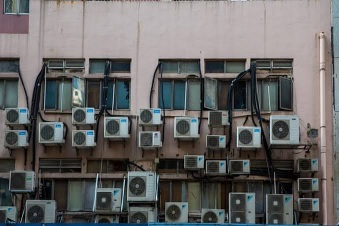As soon as the temperature rises in summer, the remote of the air conditioner (AC) comes in hand. For us, AC is no longer luxury, it has become a need. But have you ever thought that the machine with which you are cooling your room, is actually playing an important role in warming the earth? This facility of AC is putting ghee in the fire of climate change. And this is not just a technical or environmental question, but has also become a social, economic and moral question.
According to a report by the United Nations Environment Program (UNEP), if the world did not improve the field of refrigeration and air conditioning rapidly, the global temperature in the global temperature by the end of this century may increase by 0.5 ° C alone due to HFC (Hydrophlorocarbens) gases. And this is happening at a time when all countries under the Paris Agreement have pledged to keep this growth within 1.5 degrees.
The AC market in India is growing rapidly year after year. The 2022 report of the International Energy Agency (IEA) says that by 2030, the number of air conditioners in India will increase three times and by 2050, 45% of the country’s power consumption will only go into cooling. Not only this, the report also states that the demand for cooling in developing countries like India is increasing so fast that if it is not improved in time, it can make the energy crisis and climate crisis more serious.
The cold air emanating from AC actually throws out the heat of the room. The cold you get, the more heat goes to the outside environment. And when ACs are running simultaneously in every flat, office and mall of the city, it produces “urban heat island effects” – that is, the temperature of urban areas gets several degrees higher than the surrounding rural areas. According to a research by MIT, the temperature in cities like Delhi and Mumbai can be more than 1.5 to 2 degrees during summer days.
But the matter does not end here. The gases used in AC are especially dangerous for HFCs environment. These gases produce thousands of times more greenhouse effects than carbon dioxide. For example, the global warming potential (GWP) of HFC-134A gas is 1,430 i.e. its effect is 1,430 times more than Co₂.
Virbhadram Ramanathan, a climate science knowledgeable and professor at the University of California, says, “This cool technique is pushing the earth towards boiling the earth.” According to another report “Cooling Emisions and Policy Synthesis Report 2020”, if cooling systems worldwide are improved and high GWP gases are removed in a phased manner, about 460 gigaton emissions can be prevented by 2100.
This crisis in India becomes even more complicated because the huge population here, rapidly growing urbanization and excessive heat are constantly increasing the demand for AC. But it also has a social side. On the one hand, the malls, corporate offices and the houses of the rich remain cold from AC, on the other hand people are dying of heat in slums and poor settlements. This is a “thermal inequality”. That is, the coolness gets to the rich and the poor have to suffer the heat.
In a CSE report, climate activist Sunita Narayan says, “AC is no longer a question of environment, it has become a question of social justice. When the rich sections of the city are enjoying the cold air, then its effect is clearly visible in the hot settlements of the poor.”
What can be the solution?
First, it is necessary to promote energy efficient AC. The ‘Star Rating’ system of the Government of India is a step in this direction, so that consumers can know which AC gives more coolness to low electricity. Along with this, refrigerants have to change. Now technology has reached there that natural gases like ammonia, co₂ or hydrocarbon -based refrigerants can be used which are less harmful to the environment.
Second, we need to return to traditional Indian architecture. Thick walls, high ceilings, forged windows, and cross ventilation – all of these gave relief from the heat even without AC. The structure of the havelis of Rajasthan and the temples of South India is still an example. Keeping this in mind, the Government of India has launched “India Cooling Action Plan” in 2019, which aims to reduce the total cooling demand by 25-30% by 2038.
Third, awareness of citizens. We have to understand that every time the use of AC does not only increase electricity bill, but also increases the temperature of the earth. Just as we think for saving water and electricity, it is important to take restraint about cooling.
Finally, policy makers and urban planners have to believe that not every problem will be solved from machines. If we want to give the coming generations a lustable planet, then the idea of ’cooling’ has to be seen not just from machines, but also from natural and social perspective.
In a report by The Guardian, the famous environment thinker George Monbiot writes, “We cannot solve the climate crisis from the same mentality that we have produced it – the appetite for consumption and the addiction of consumption.”
So next time you pick up the remote of AC, stop once and think- is it just your cool, or the peace bought at the cost of someone else’s heat?
